The 31-year-old Serbian defensive midfielder Nemanja Matić has extended his contract with Manchester United. The left-footed midfielder will be staying in Manchester United for one more year.
After 2018 FIFA World Cup, he suffered from injuries and his 2018-19 season was blighted due to this. At the beginning of this season, injuries still bothered him until December. Nevertheless, when he recovered from those injuries, he found his form back on the pitch. He was constantly deployed as a defensive midfielder in the big games, teaming up with Fred. He performed quite well against Manchester City and Chelsea, and his performance was vital to the victories: United won two derbies within two months and Matić scored the winning goal in January.
His fantastic performance in these big games was part of the reason that his contract was extended in March for one more year. However, putting this aside, we want to know the main reason why he is offered an extension to his contract.
With the doubt put forward, we will try to solve this question in this tactical analysis. This scout report details key attributes of Matić, and how his attributes affect United’s tactics.
Data analysis
Before we delve into his attributes, we first use some statistics to give you a brief impression on Matić. Then we will compare his stats to his position mates in the team to find out their differences in style, and this comparison will be of use in the later section of this analysis.
First of all, we are showing a radar profile of the player to give you a brief impression of Matić’s style of play.
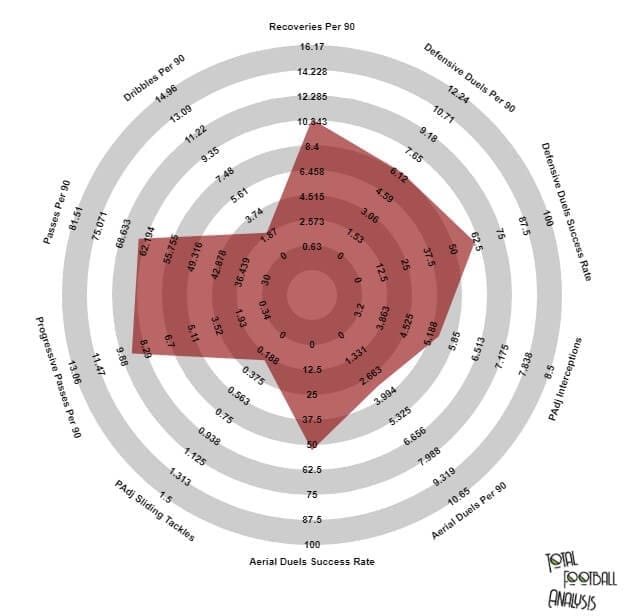
In this radar chart, we use the maximum and minimum numbers in the Premier League of each item to outline the outer circle and the inner circle.
On one hand, we can observe that the defensive actions he committed into the game are limited, but with a good success rate. For example, 194 cm tall though he is, he only goes for 3.32 aerial duels per 90, while the success rate reaches to 52.63%. What’s more, as a defensive midfielder, he only has 6.3 defensive duels per 90, ranking the 68th among all the midfielders, whereas the success rate is high (62.5%). Even though his stats don’t stand out when it comes to proactive defending, but he possesses a good number in recoveries per 90, which is 10.41, ranking the 11th among all the midfielders in the Premier League.
Offensively speaking, he delivers quite a lot of progressive passes (9.21), ranking the 29th of all midfielders in EPL. Furthermore, he has 64.06 passes per 90 with an accuracy of 88.68%, ranking the 18th in the league. However, his dribbling stat suggests that he is a restricted dribbler, with only 2.01 dribbles per 90.
Now, we will compare his stats with his three-position mates in the Red Devils, who play mainly as defensive midfielders, Fred, Paul Pogba and Scott McTominay. We also want to know why Matić’s is unique when comparing to his counterparts.
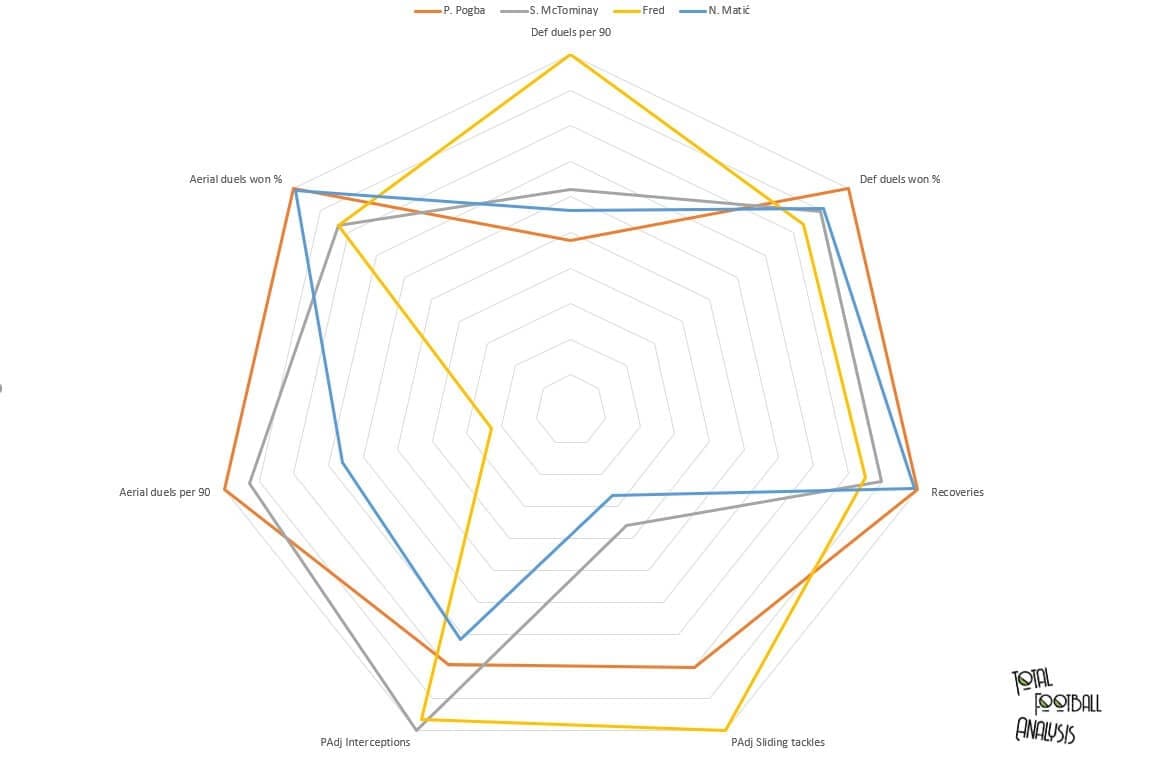
From the first glance we could see that comparing to his position mates, his stats in defending is not that outstanding. He takes the last place amongst all four players in terms of PAdj interceptions and sliding tackles, which is 0.23 and 5.41 respectively. (PAdj here stands for possession-adjusted since you could only make a defensive contribution when you are out of possession). McTominay has the most PAdj interceptions (7.55) and Fred has the most in PAdj sliding tackles (0.86).
When it comes to aerial duels, the 194 cm Serbian only ranks the third with 3.32 per 90, while Pogba dominates with 4.14 per 90. On top of this, he only ranks the third in defensive duels per 90 while Fred excels in this aspect with 11.11. Nevertheless, the success rate of aerial and defensive duels are high for Matić, 62.71% and 60.58% respectively, both ranking the second among the four midfielders. He also has 10.41 recoveries per 90, ranking the second while Pogba has 10.51.
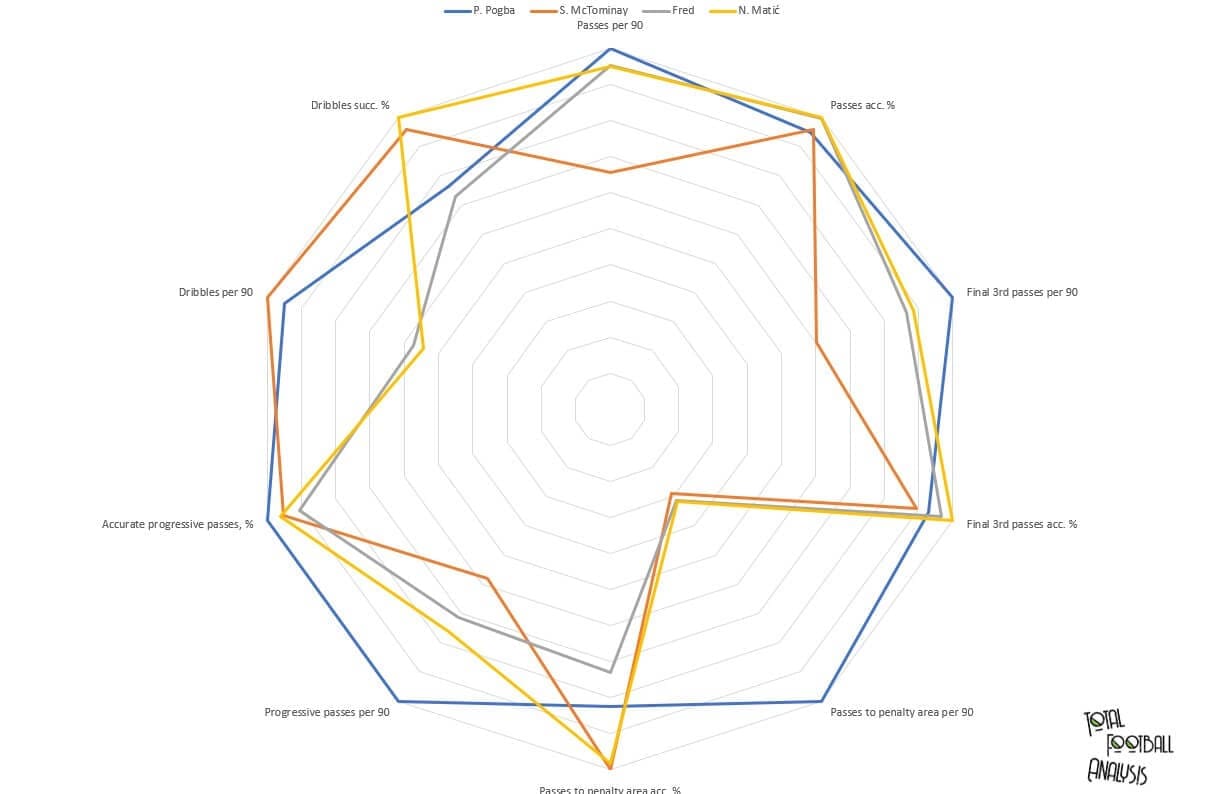
In the above radar graph, Matić’s data was outlined with yellow. Matić is better than his counterparts offensively, while the only item in which he ranks the last is his dribble per 90 (2.1) while the dominator in this aspect is McTominay (3.87).
His numbers and accuracy in different types of passes are stably good, especially those passes that get the teammate in a more threatening position. He has 9.21 progressive passes per 90 with an accuracy of 52.94%, ranking in second for both, while Pogba has 12.1 per 90 with an accuracy of 82.02%; 11.08 final third passes per 90 taking the second place, with an accuracy of 83.13%, leading amongst the four midfielders. He also has 1.55 in passes to the penalty area, with 52.94% in the accuracy, once again coming in second for these metrics as well.
It seems that he contributes more in attacking than defending, as he played more passes getting his teammates into a more threatening position effectively. However, data might not show the whole story, and we will further investigate the player from a tactical point of view below.
Offensive assets
The data analysis suggested Matić is a good passer, and it was not without reason. Firstly, the Serbian international constantly scans around and shoulder-checks to perceive visual information. This enables the player to observe the positioning of opponents, as well as that of his teammates. Matić also has the vision to switch the play or pick teammates up front.
Since Matić often anticipates opponents and his teammates, he seldom panics and is able to resist pressure in tight spaces centrally, by using his touches and well-timed passes to escape the opponent. He is less likely to play directly, even when under pressure, and this helps United to keep possession.
These are some prerequisites for a fantastic pass. When it comes to the execution, he has the option to exploit the dynamics through first-touch passes. Alternatively, he could take touches to absorb pressure, creating spaces for the receivers. These are two common ways Matić uses in the offensive phase.
He could pick out his teammates’ strong foot accurately as well, even if he is surrounded by a few players. This could be useful for the team when United play out from the back. Thanks to the strong passing of Matić, United can play forward even in tight spaces of the pitch centrally. And United can be more pressure-resistant when being forced through the middle. With Matić’s ball-playing ability, United control the ball better, and are able to break the pressing traps with ground passes.
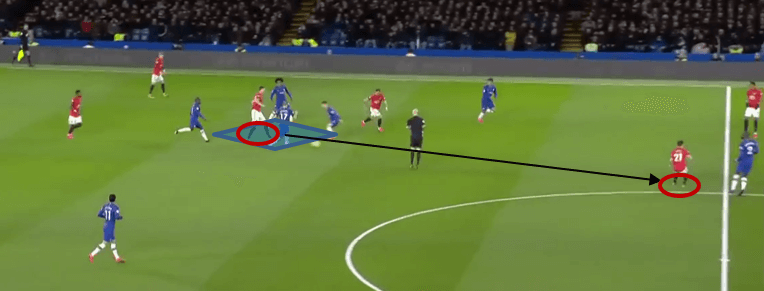
In the above example, United were encountering Chelsea’s 4-3-3 pressing block. Chelsea committed quite a lot of players at the half-spaces. As a receiver, Matić was caged in the diamond shape of Chelsea as his first touch moved the ball into it.
Matić took two more touches to instigate the player at the bottom of the diamond to step up. This created more space for teammates between the lines to receive and then progress play.
As the bottom player pushed up, Matić found the angle to pass, which broke the six-man pressing block to find Daniel James in the central area. This allows United to progress through the centre, which was often more threatening than attacking the flanks.
Apart from the ability on the ball, his off-the-ball action is also conducive to United’s offensive phase. Since Matić is not mobile enough to cover huge ground, the positioning and timing of his runs are crucial. These offer an effective passing option for the defenders. He usually vacates spaces, and times his run into that space to serve as a link player. Afterwards, he tries to find the free player, who should be on the opposite flank. This helps United to attack in a more unpredictable manner, as Matić can play the ball to the speedy wide players.
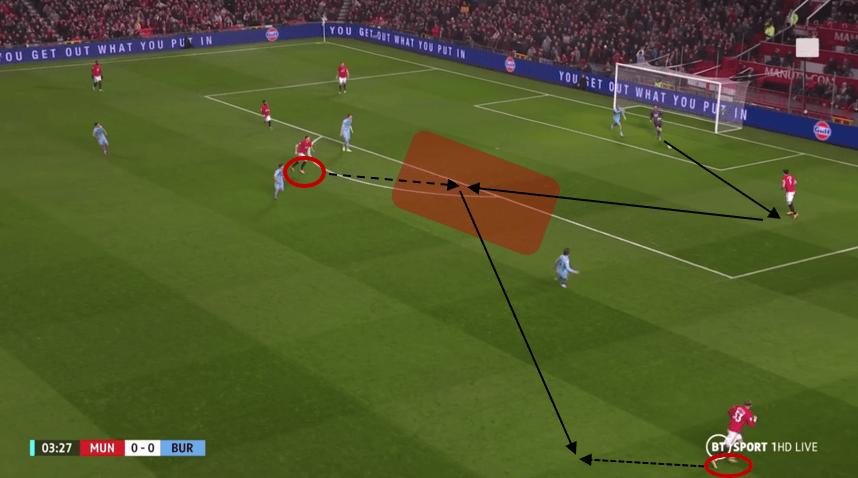
In the above image, United were trying to play out from the back against Burnley’s pressure. Matić was marked tightly. His open body shape enabled him to see an opening in the central area near his own box in advance. However, he didn’t rush into that area because it will also invite pressure onto the ball.
Therefore, Matić had to wait for the right moment: when Harry Maguire receives the ball on the left. Then, he used a one-touch pass to find the left-back, finding the free man for progressing the ball in an unmarked area.
His attacking positioning also enables him to collect second ball or free ball, maintaining possession for United and restarting the attack. This allows United to commit one more midfielder in the front since Matić could play the progressive passes.
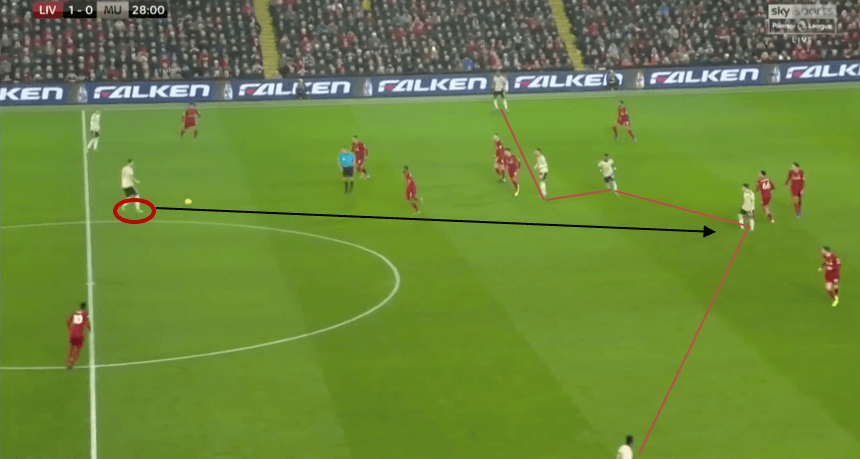
In the above example, United’s progression was denied by Liverpool due to an unsuccessful long pass. Matić was positioned in a good spot from where he could press the opponent if United lost possession. However, this positioning also gave him a good angle to pass if he was going to receive the ball.
Eventually, the ball fell in Matić’s area. We could see that United still had a lot of bodies in the front line without dropping immediately. His midfield partner Fred was also staying between the lines. This is mainly because of Matić’s ball-playing ability that even under some extreme pressure, he didn’t need an extra body in the midfield area to serve as a lateral pass option. So Fred could still stay up as a forward passing option. After Matić got the ball, he broke the line and picked teammates up front, restarting the attack in an advanced area.
Defensive and transitional contribution
When deployed as a defensive midfielder, he is not scintillating in terms of stats. Matić is not an N’Golo Kanté type of defensive midfielder that runs a lot off the ball. It is impossible for Matić to keep intercept and tackle when covering spaces because of his age (31) and lack of mobility.
However, Matić’s tactical knowledge and reading of the game are fabulous. He makes some smart decisions, which require fewer runs but help the team through his defensive positioning and covering. These kinds of contributions are unquantifiable.
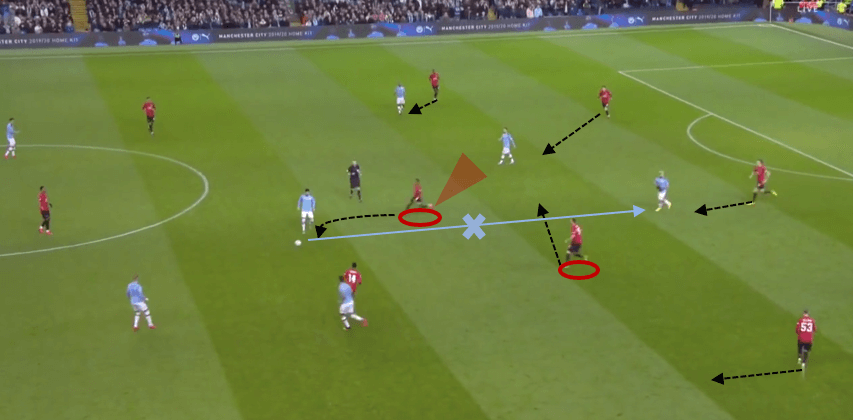
United could set a higher press as Matić could provide the defensive cover in front of the backline. He could eliminate the opponents’ forward passing options.
In the above scenario, City’s right-back was passing to the midfielder. The pass was a bit slow, Fred recognised the pressing trigger and curved his run to prevent the target from turning. His curved run also shadowed one forward passing option at United’s right half-space.
Matić saw this and shifted across the field, covering Fred. More importantly, he also eliminated another forward passing channel in the centre. Due to his positioning, now United’s whole block could move forward and press as a whole. Consequently, City didn’t have forward passing options in this scenario. They were forced to play back and United could move up further.
His positioning also contributes to the offensive transitions. In the first part of this analysis, I’ve mentioned that his stats on recoveries are outstanding in the league. This can be attributed to his splendid positioning which helps him regain possession.
What Matić does better than anybody else is his proactive mentality in the transition. When he recovers the ball, he doesn’t need extra time for touches. Playing one-touch passes to release the ball forward is his strength. He can therefore exploit the timing to initiate a counter-attack, utilising his one-touch pass. This kind of action would help United in the counterattack since the need is to play forward quickly in this phase.
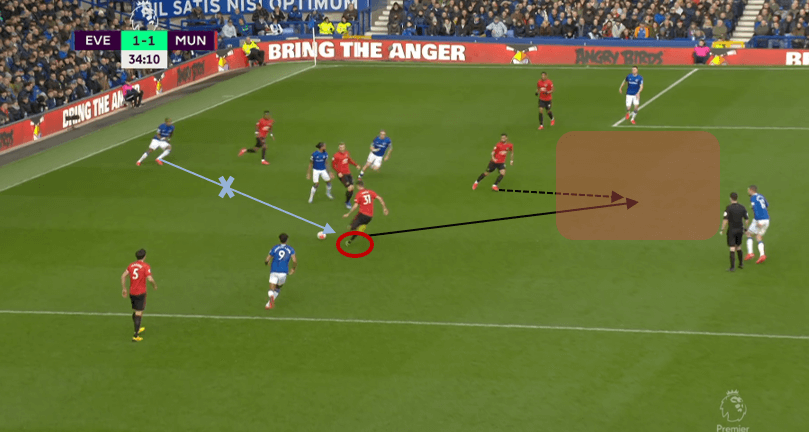
The above image is an example of his recovery in the midfield against Everton. This recovery eventually led to a goal for Bruno Fernandes. In this scenario, Everton were attempting to play out from the back and United pressed high. The ball was forced to the flank and Everton had an errant pass.
Matić chose a good position to cover his pressing teammates and at the same time increased the possibility of picking up the free ball. Before recovering the ball, he already recognized spaces in the central area. He didn’t hesitate when intercepting the misplaced pass and hit a one-touch pass to that space. The pass guided Fernandes into a scoring position where the opponents were too far away from him to give pressure.
Weaknesses
Matić is a bit slow in pace and immobile, though he can atone for it with his positioning. He needs time to accelerate and decelerate opponents could exploit this by utilising quick combinations around him. Also, the midfield is usually only covered by the two defensive midfielders. That means they need to have horizontal coverage in the midfield area. Therefore, the opponent can use switching play to catch the moment when Matić does not get back in his position on time and make use of that time and opening.
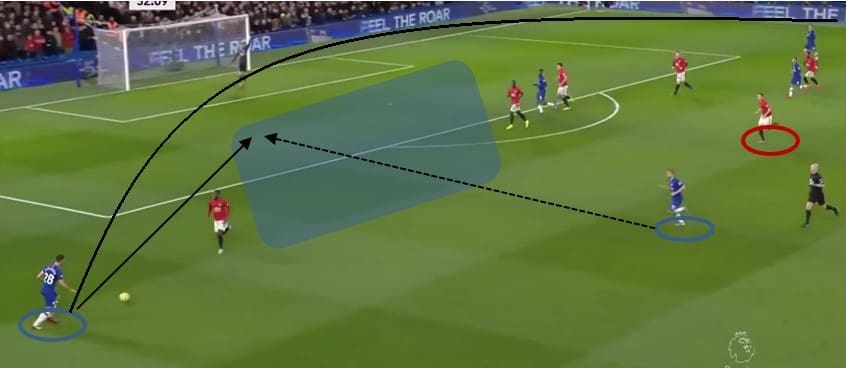
The above example shows exactly what happens when the opponent can use a switch of play to create an opening around Matić’s area. Chelsea were attacking United’s left flank in the first place. Matić clustered to the left flank to cover and help his teammates. He stayed close to his midfield partner Fred and covered his back. However, Chelsea managed to switch the play to United’s right flank. This created a huge gap near the box and as Matić was too slow to shift across and close it down. Chelsea then had a numeral superiority on this side and created a high-quality chance. Therefore, Matić adversely affected the ability of United to shift the block.
Another issue that the opponent could make use of is his risky mentality in passing. He does possess a great accuracy in the progressive pass and other kinds of passes, but sometimes even if the situation is really not suitable for forward passing, he still desires to pass forward. This might lead to losses in his own third of the pitch. Furthermore, he often plays as the last man in the midfield line, so when his pass gets intercepted, the opponent can attack facing only one line of defence. This could bring United into some dangerous situation, where the opponent could start the attack close to United’s goal.
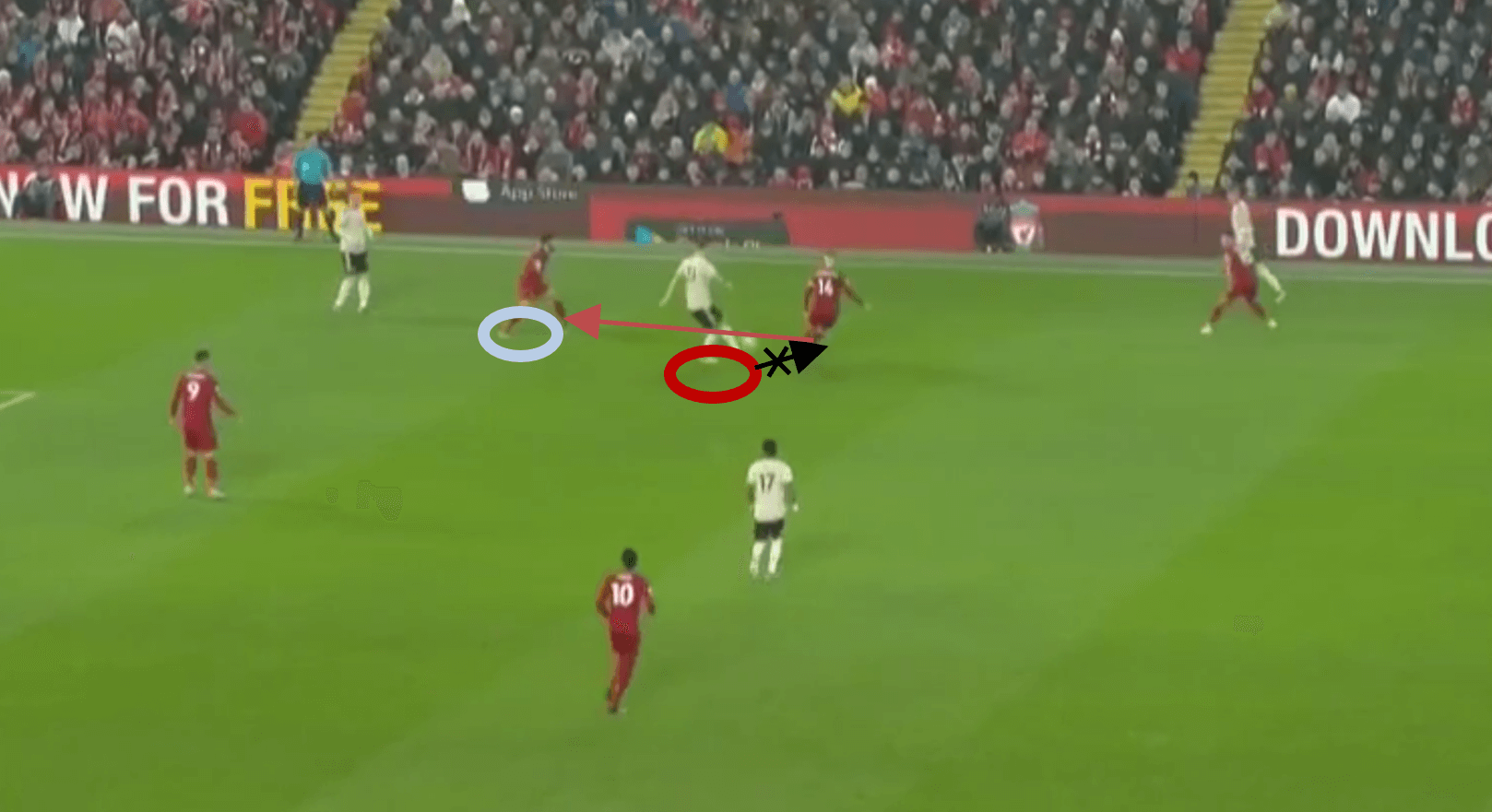
In the above scenario, there was no available forward passing channel. Nevertheless, Matić still attempted to pass forward, whereas he did have other passing options. His pass was intercepted by Jordan Henderson and the ball bounced into the feet of Mohamed Salah. Liverpool could counterattack quickly and create a scoring chance.
His USP and the chemistry with his teammates
In this section, we will continue to address the importance of Matić. We will try to figure out his USP and what he can offer specifically to his midfield partner.
We’ve already mentioned USP in the first section, which stands for unique selling point. This is a concept from marketing which means the essence of what makes your product or service better than competitors. When we try to figure out the USP of Matić, firstly we need to know the “competitors” of Matić. The competitors here are his defensive midfield mates, Fred and McTominay since we want to find out what he does better than his position mates so that he stays. We won’t include Pogba here as a competitor since he didn’t play a lot in this season.
Compared to Fred and McTominay, Matić possesses a great sense of protecting the gap in the defensive line, whereas Fred and McTominay don’t have the awareness to do so. He can protect the space in front of the defensive line better than these two, while they are more forward-minded. Below is a comparison of their awareness to protect space:
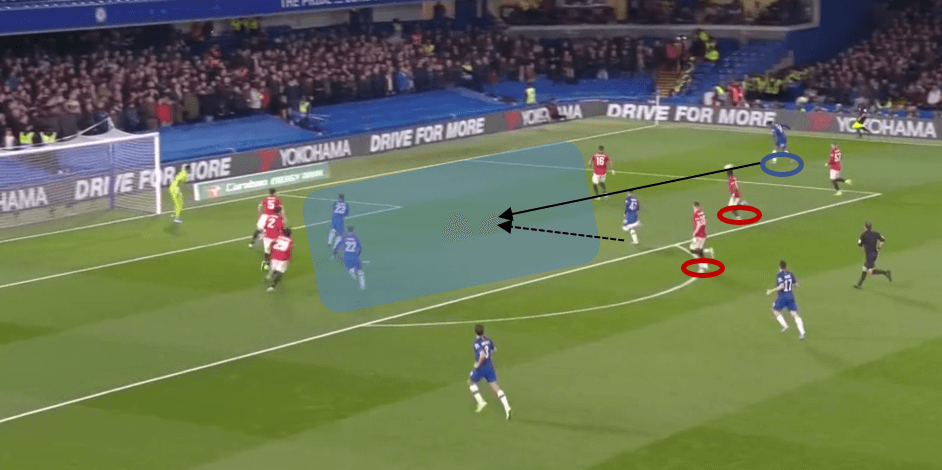
In the first image, Fred and McTominay were pairing up as the defensive-midfield-duo. In this scenario, Chelsea was attacking down the right while Fred and McTominay were retreating. However, their runs couldn’t cut the passing lane into the box. The space in front of the defensive line was still available for the attacking side. On top of this, there was a huge gap between the full-back and the centre back, where the opponent forward could receive the ball in space. Neither of them had the awareness to close the gap down. Chelsea then created a high-quality chance in the box.
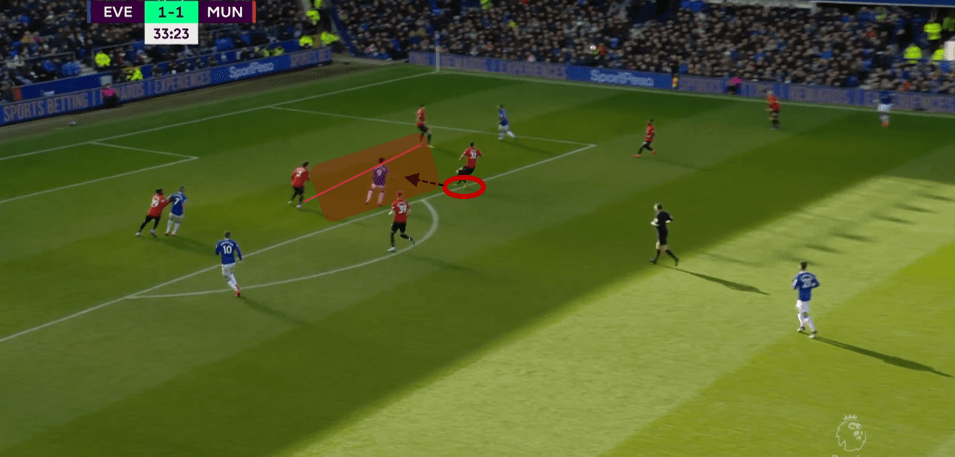
In contrast, in the second image, Everton was attacking down the right too, but there was enough protection from Matić. He ran back early in front of the gap between two centre backs, creating a 3v2 in the box and closing down the gap between two centre backs and the space in front of the defensive line. Then the opponent crossed into the box and Matić anticipated the route and recovered the ball.
Apart from the awareness to protect key space, compared to McTominay, Matić has better positioning and movement in attacking when off the ball. So he can offer more support in the midfield for defenders than McTominay, helping to keep possession and progress the play. Stats could tell when it comes to received passes and passes per 90. In the first part of the analysis, we could see from the offensive radar graph that McTominay’s passes per 90 are the least amongst the four. He only has 44.71 passes per 90 and only 31.63 received passes per 90, while Matić has 64.06 passes per 90 and 45.43 per 90. McTominay receives fewer passes and therefore delivers fewer passes than Matić. This is due to him mistiming his runs and his positioning to receive the ball, and he can’t serve as an effective passing option for defenders to link up the play. Below is an example of his mistimed run:
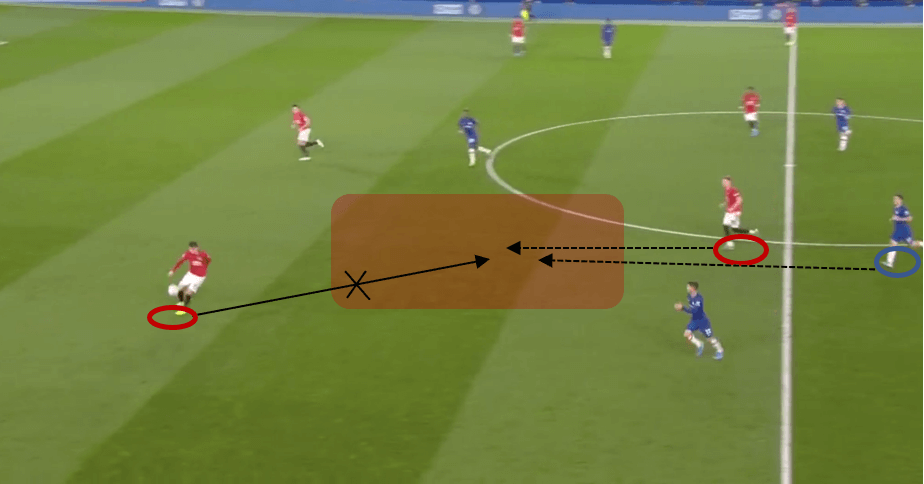
In this scenario, Victor Lindelöf just collected the free ball, but he didn’t look up and have the vision of McTominay who was already dropping back. McTominay ran too early into the space whilst Lindelöf was not ready to hit the pass. The early run brought his marker into the space as well. When Lindelöf was finally available to hit the pass, McTominay was already marked by his opponent and he would be too risky to be picked. Lindelöf then was forced to hit long. This kind of mistimed run will force defenders to play back or hit long, where neither helps progress the play. Thus, Matić can offer more support in the midfield for defenders than McTominay, helping to keep possession and progress the play.
Compared to Fred, his decision-making and pressure-resistant are better. Fred could have some errant pass and he will also hit long sometimes when under pressure. The accuracy of progressive passes could tell. Fred has the worst accuracy of progressive passes amongst the four (74.29%) whilst Matić has 78.71%. Below is an example of Fred’s errant pass in a nearly similar situation as the example of Matić we’ve discussed in the second section:
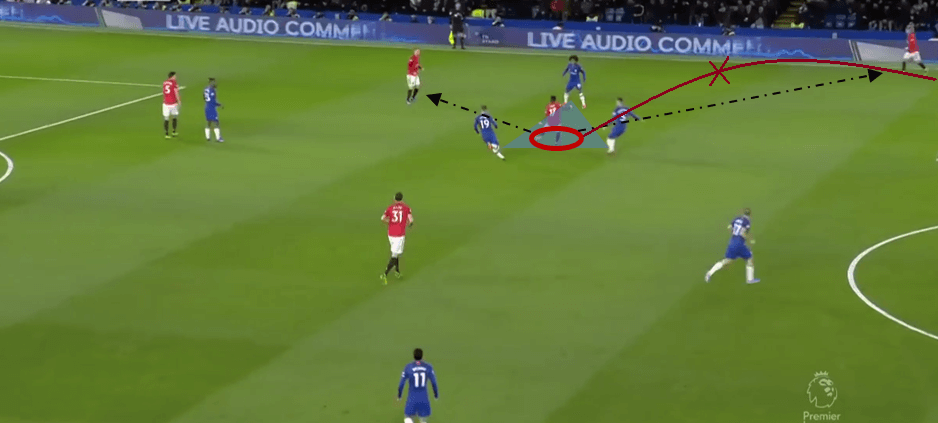
Fred was surrounded by 3 players of Chelsea, whereas Matić was caged by a four-man diamond in the previous example. Fred had the chance to pass laterally or backwards while Matić didn’t have in the previous example. Fred chose to hit it long and eventually dispossessed in this scenario, while in the previous example Matić was more composed and passed to an advanced teammate accurately. Thus, Matić was outperforming Fred in terms of pressure resistance and decision-making.
After talking about Matić’s USP, we now delve into the chemistry between him and his position mates. From the defensive radar graph of the first section, we can see that Fred dominates in defensive duels per 90 (11.11) and Padj sliding tackles (0.86). He challenges the ball quite often, and he is mobile enough to challenge the ball everywhere on the pitch, which might help United win possession. However, when he challenges upfront, the space behind is exposed. When he teams up with other defensive midfielders, they don’t cover well enough and the space behind Fred can be utilised. That’s where Matić could help Fred. With Matić’s fantastic covering and positioning in his back, Fred can have the permission to leave his zone to press and challenge the ball everywhere on the pitch, taking advantage of his mobility and winning a lot of possessions for United. This could also free Matić from running out of his zone too many times to press. He could just focus on his positioning which can save his physical strength and prolong his career. Attacking wise it’s the same as Fred can go forward to join the attacking unit while Matić serves as defensive cover.
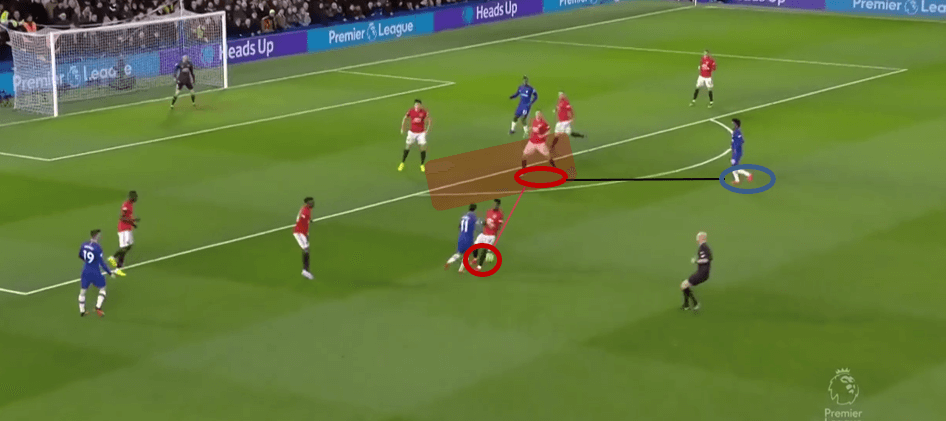
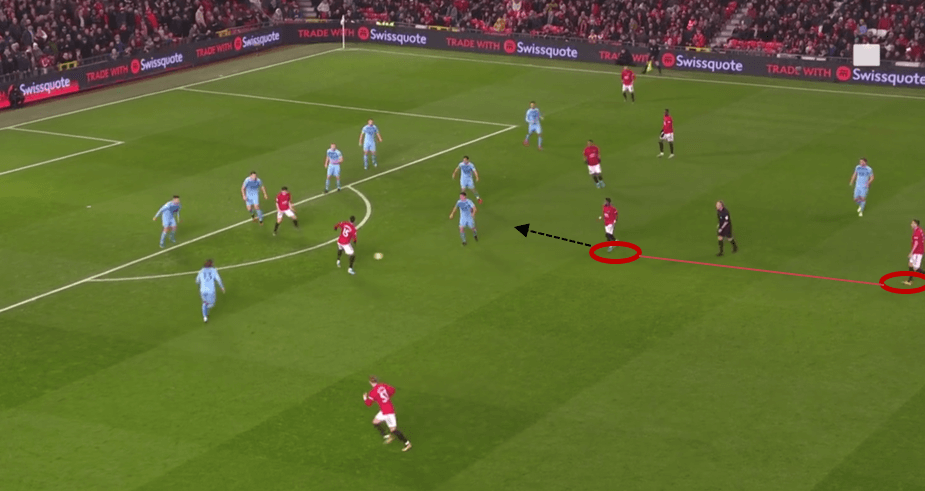
The above images show how these two players complement each other. The first image shows Matić’s positioning. Fred was pressing the opponent and challenging the ball and so Matić covered his back. At the same time, he marked his opponent at a good distance and also protected the gap in the defensive line in front of the defenders. In this way, Fred could challenge the ball without too much hesitation and concern. Then Fred successfully gained possession at the back. In the second image, we could see that Fred could join the attack in the final third due to the cover Matić provided. One more body could be added in the second line of United’s attack and Fred could use his great technique in shooting or dribbling closer to the goal.
After discussing the chemistry with Fred, we now take a look at the chemistry with McTominay. The chemistry between these two midfielders is not as good as the partnership between Fred and Matić, but Matić still manages to provide cover for the 23-year-old Scottish international. McTominay has the most dribbles per 90 (3.87) and Padj interceptions (7.55) amongst the four. Compared to Fred he will push deeper into the final third, with a lot of runs into the penalty box. In this case, McTominay has a longer distance to recover to get into his defensive position, exposing Matić to the opponent’s counter.
Conclusion
The key question of this analysis has now been solved. We’ve delved into his traits and how they can improve team performance. Also, we’ve discussed his unique selling point, what he can offer to the team which United’s other midfielders cannot. Then we also see how he could help his teammates to get the best of them. These are the three main aspects that we try to use to answer the key question, whilst also using data as supporting evidence.
This 31-year-old veteran could also impart his football knowledge and experience to Fred and McTominay. With his great positioning and decision-making, defensive midfielders at Manchester United could really learn from him and become smarter players.

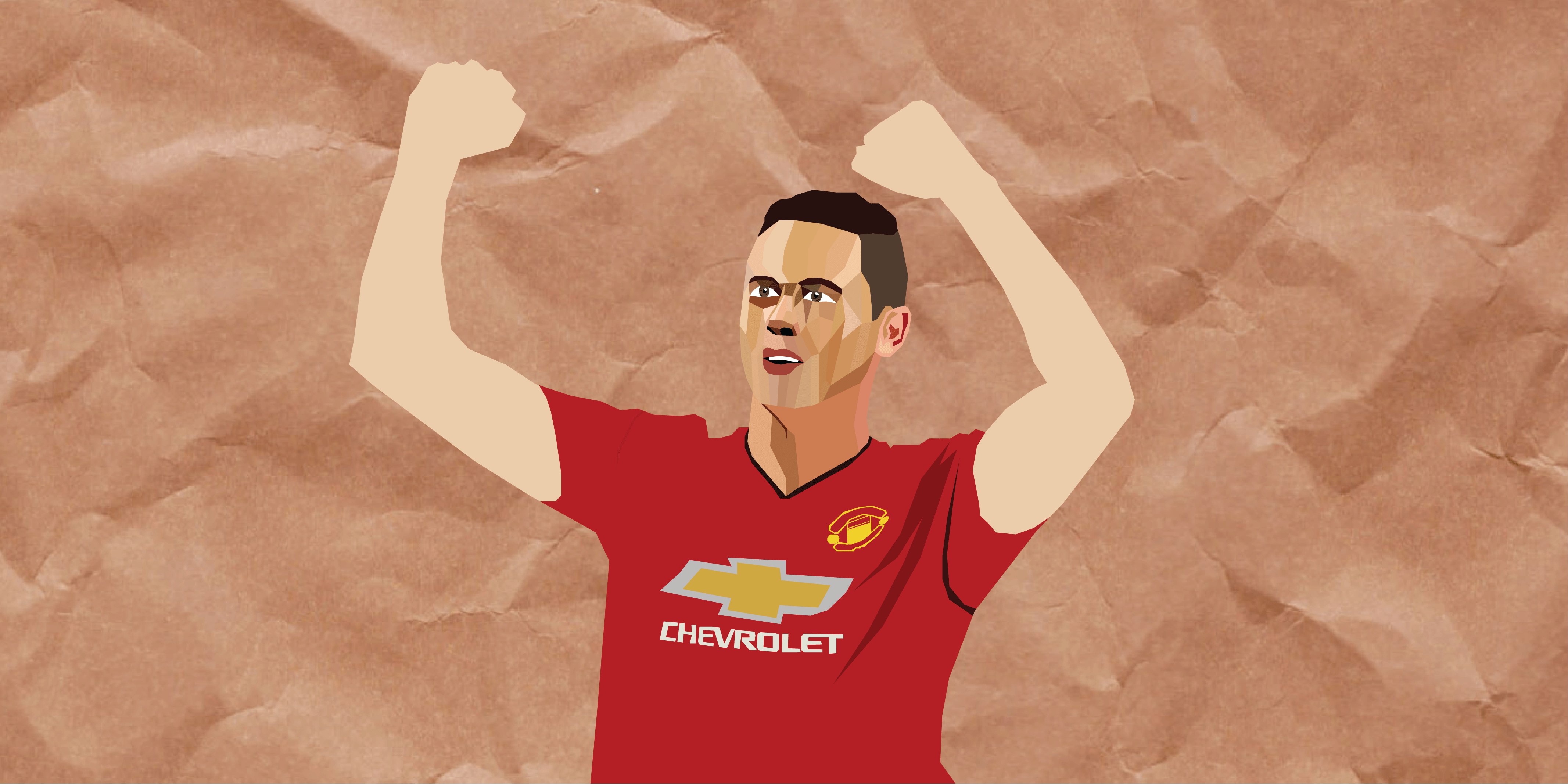



Comments